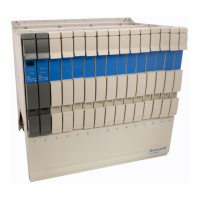3 UCN Status Displays
3.4 Display Operation
206 HPM High-Performance Process Manager Service R688
Honeywell December 2020
Table 31 EUCN Network Statistics Display Definitions
For EHPM, the node type on this display shows HPM.
The indication of a cable failure is the same as with the
traditional coaxial cable. However with FTE, the EUCN
network can ride through a single cable fault per node.
Multiple cable faults can be mixed across nodes (For example,
a fault on cable A on EHPM 7, and a fault on cable B on
EHPM 9). In FTE, the definition of the active cable has no
meaning. FTE does not have an active cable. However, it
uses the best cable, and both the cables are connected
through the crossover cable.
If one of the FTE cables is disconnected or has failed, then the
A SIL is marked with an asterisk. This also causes the UCN
cable to be marked/alarmed as FAIL.
If one of the FTE cables is disconnected or has failed, then the
B SIL will be marked with an asterisk. This will also cause the
UCN cable to be marked/alarmed as FAIL.
If the cross-over cable (at the FTE switch) is disconnected,
then both the A NSY or B NS is marked, and this also causes
the UCN cable to be marked/alarmed as FAIL.
If the cross-over cable (at the FTE switch) is disconnected,
then both the A NSY or B NS is marked, and this also causes
the UCN cable to be marked/alarmed as FAIL.
An asterisk (*) indicates that UCN cable auto-swap is disabled
(partial frame with missing start delimiter).
For FTE, this statistic has no meaning, it is always zero (0).
For FTE, this statistic has no meaning, it is always zero (0).
For FTE, this statistic has no meaning, it is always zero (0).
For FTE, this statistic has no meaning, it is always zero (0).
For FTE, this statistic has no meaning, it is always zero (0).
The total number of times the node attempted auto reconnect.
The status of the node’s Time Synch. (INITIAL, FAILED,
SYNC FAILED, DEGRADED, LCN BAD, LCN OK, or OK).

